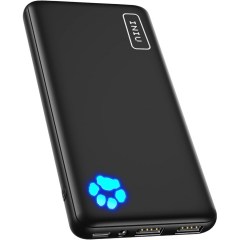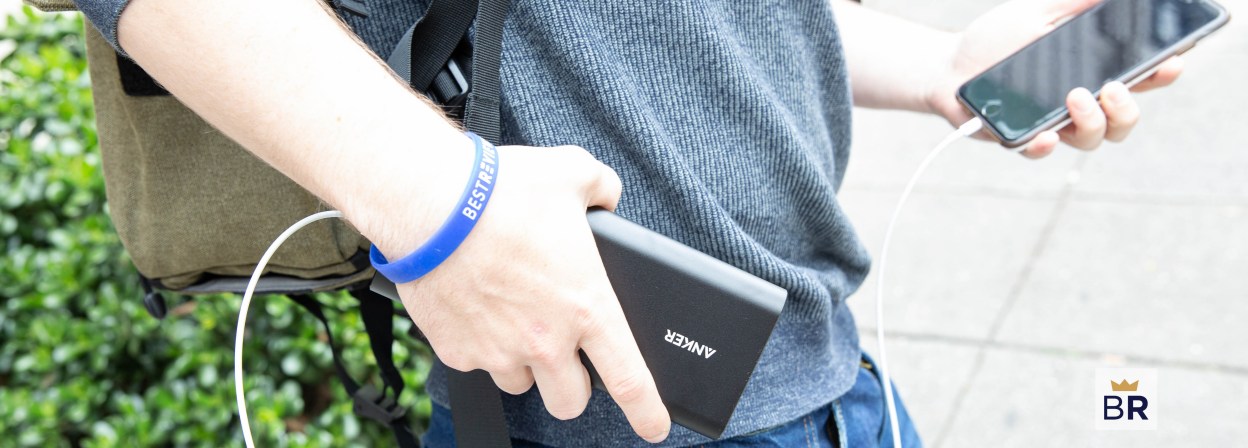BestReviews is reader-supported and may earn an affiliate commission. Details

The fairly priced PowerCore III Elite is the best power bank for buyers who need a versatile model.
Features USB-C and two USB-A ports. The device fully recharges in 3 hours. Easily charges a laptop. Trickle-charging mode for delicate electronics. Charges a smartphone 4 or 5 times.
The power bank is too chunky to fit in your pocket.

If you have just 1 portable device to keep charged, this unit is well worth a look.
This portable charger boasts a fantastic price, is very portable, and has a decent battery, offering 5,000 mAh. Made by a well-known brand. Users enjoy how compact it is and how easy it is to store.
It has only 1 USB port, and it charges devices slowly.

A great power bank that can hold a large charge and offers quick charging capabilities.
Power bank holds a 10,000 mAh charge, enough to charge a phone multiple times. Quick charging capable of outputting 12W for high-power devices. Overcharge protection and temperature control.
Only has a single USB-A port.

Great power bank for anyone with a wide range of devices.
Extremely fast charging speeds. Charge up to 3 devices at once. Wirelessly charges all Qi-certified devices. Features 2 USB-C ports. Affordable. Compact. Slim.
Only available in silver.

This power bank from Iniu is thin, light and powerful.
It holds 10,000 mAh, which can fully charge an iPhone 15 or Samsung Galaxy S22 just shy of twice. It charges at 3A speed, which can jump an iPhone to almost full in one hour. It comes in four colors.
Some noticed that it can get hot when charging or being charged.

We recommend these products based on an intensive research process that's designed to cut through the noise and find the top products in this space. Guided by experts, we spend hours looking into the factors that matter, to bring you these selections.

Since the dawn of the smartphone revolution, we’ve lived with ongoing angst that we’ll someday run out of battery at exactly the wrong time. Whether it’s a TV binging session or a video call with a loved one, no one wants their device to die in the middle of something important. To tackle this fear, a new product has emerged: the power bank.
Power banks are batteries inside a metal or plastic enclosure that you can use to charge your devices. They’re perfect for situations in which your phone needs some juice and there are no outlets to be found.

There are a lot of different features that differentiate various power bank models, but far and away the most important one is storage capacity. A power bank has one job: to receive and store energy for your devices. It makes sense, therefore, that available storage is the most important attribute.
Power bank capacities are rated in milliamp-hours (written as mAh), which is a measurement of charge that’s sometimes referred to as current flow over time. So how many milliamp hours do you need?
Consider these comparisons.
iPhone batteries typically have a capacity of around 2,000mAh.
Samsung Galaxy phones have a battery that stores 3,000mAh.
Typical laptop batteries store 5,000mAh.
Power bank capacities vary widely, but they will always be listed as part of the product specifications. As you’re looking for a power bank, make sure to get one that holds enough for all of the devices you want to use it with.




















As you’re researching power banks, you’re likely to come across a soup of industry terms. Here are the three that matter the most.
mAh: This is a measurement of a battery’s capacity. For example, smartphones generally have batteries of 2,500mAh, and power banks can store anywhere from 3,000mAh to 40,000mAh. The bigger the mAh number, the more power it holds.
Lithium-ion and lithium-polymer: There are two types of batteries used in power banks: lithium-ion batteries and lithium-polymer batteries. The terms describe what the batteries are made with. Both are decent, but notably, li-polymer batteries tend to last longer and cost more. If you can afford a power bank with a li-polymer battery, you should buy it. Otherwise, take heart knowing that li-ion batteries are a completely acceptable alternative.
“Smart Charge” feature: Some power banks have multiple ports, and they’re able to determine the right amount of voltage to use based on the connected device. This feature is often called “Smart Charge,” but in some cases, it’s a feature without separate branding. With Smart Charge, you can be certain that every connected device is charging as fast as it can.
Power banks are generally affordable, but it’s important to know what you are – and aren’t – getting for your money. As you’re picking out a power bank, keep these three main price ranges in mind.
In this range, you’ll find low-capacity batteries and no-name brands. Power banks are a great example of “you get what you pay for,” so it’s best to avoid models in this price range.
At this price point, expect to see the best performers. Power banks in this range have ample storage, plenty of connectivity options, and handy bonus features like LED status lights that indicate how much power is left inside.
You can find some luxury models that can power just about anything. If you expect to recharge multiple devices on the go – and at least one of those devices is a laptop – expect to pay a little more.

As you look for a power bank, consider these tips.
Buy a dedicated USB cable for your power bank, and keep them together at all times. It’s easy to lose track of USB cables, so make sure you’ve always got one handy when you’re ready to use your power bank.
If you don’t expect to use your power bank frequently, set a calendar reminder to charge it. Most power banks will hold energy for a long time (anywhere from weeks to months), but if you only use yours occasionally, you’ll want to keep it charged regularly. No one wants to reach for their power bank during a power outage only to find it’s out of power!
Recharge your phone to 80% or 90% with your power bank; avoid charging it to a full 100%. When a power bank is getting recharged, the last 20% or so will take much longer than the first 80%. What’s more, when a power bank remains plugged in after being at 100%, it’s still consuming energy and replenishing it, wasting battery life.
If you’re often in a hurry, consider a power bank with Quick Charge technology. With this technology, certain Android phones can charge much faster than others. Using Quick Charge, a supported phone can recharge up to 80% of its battery in 30 minutes.

A. It depends on the quality of the power bank. High-end power banks can hold a charge for up to six months, and low-quality power banks can discharge completely within a few weeks. If you expect to only use your power bank once in a while, avoid no-name brands and any model that’s poorly reviewed.
A. Power bank charging times vary depending on the power bank’s capacity – larger batteries take longer to charge – as well as the type of power adapter. Some power banks use USB cables for power, while others come with AC adapters that plug into the wall. Not surprisingly, charging from the wall is faster.
The average power bank takes between eight and 12 hours to charge via USB and about half that if plugged into the wall. Not all power banks support both charging methods, so be sure to note which ones meet your charging needs.
A. Yes, sort of. The USB 3.0 standard can transfer more data and power than the USB 2.0 version. This means that if your power bank has a USB 3.0 slot, your device supports the faster charging of a USB 3.0 connection – and if you use a USB 3.0 cable, you’ll charge faster than you would if any one of the components relied on USB 2.0.
The USB 3.0 standard is backward compatible, so it has no problem charging USB 2.0 devices. If you can afford to, buy a model that features at least one USB 3.0 port.
Get emails you’ll love.
Learn about the products you’re wondering if you should buy and get advice on using your latest purchases.
